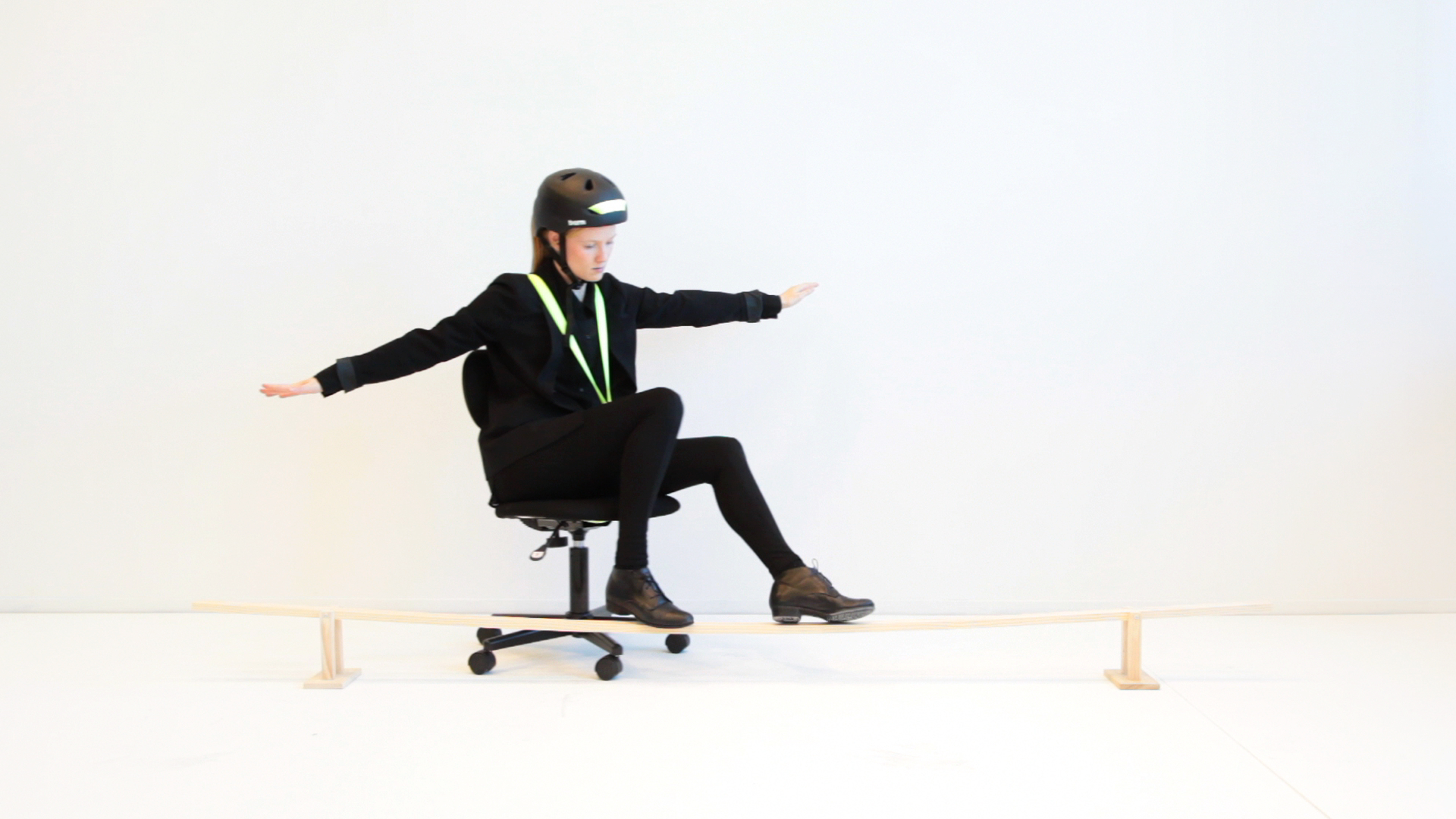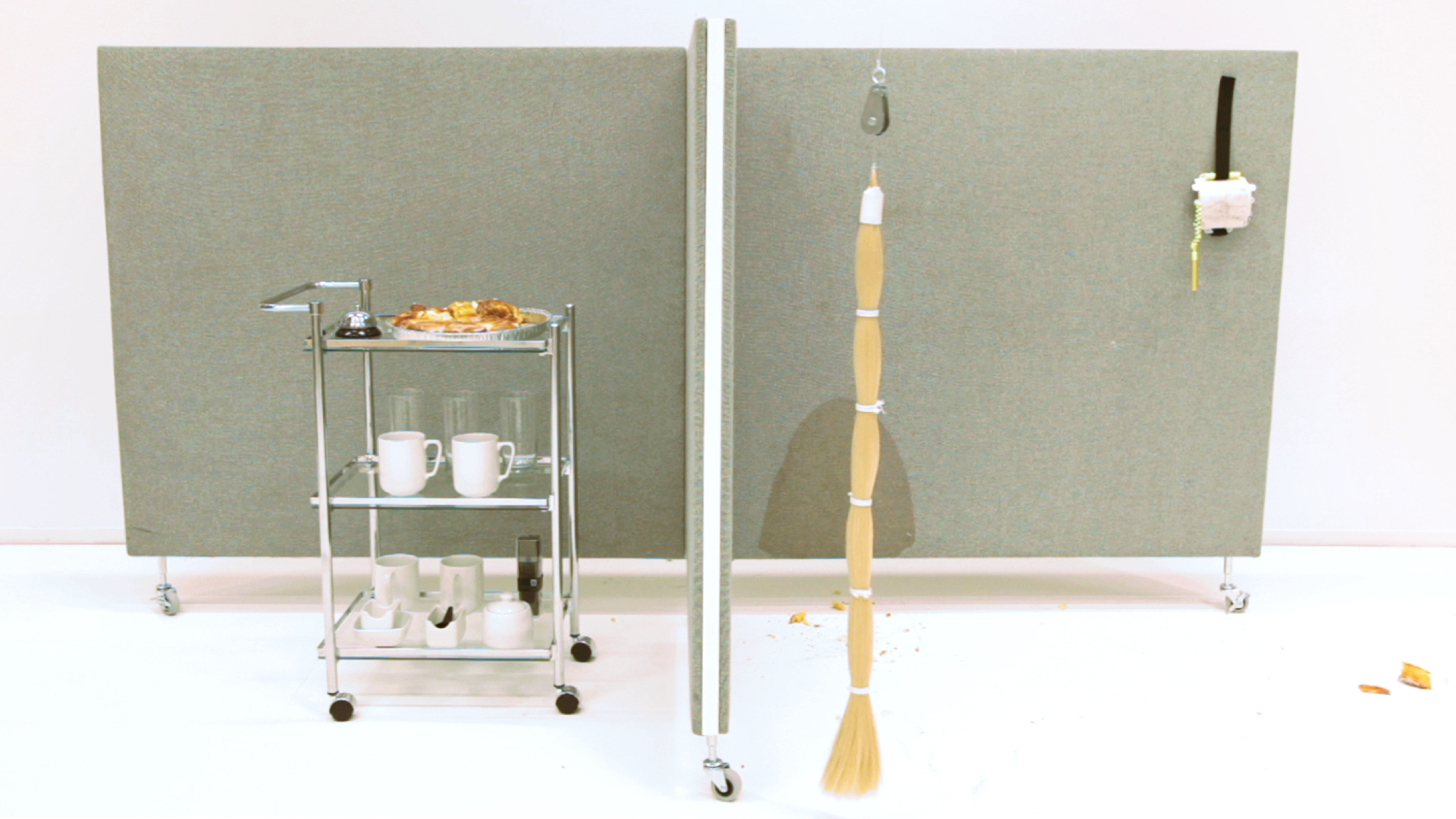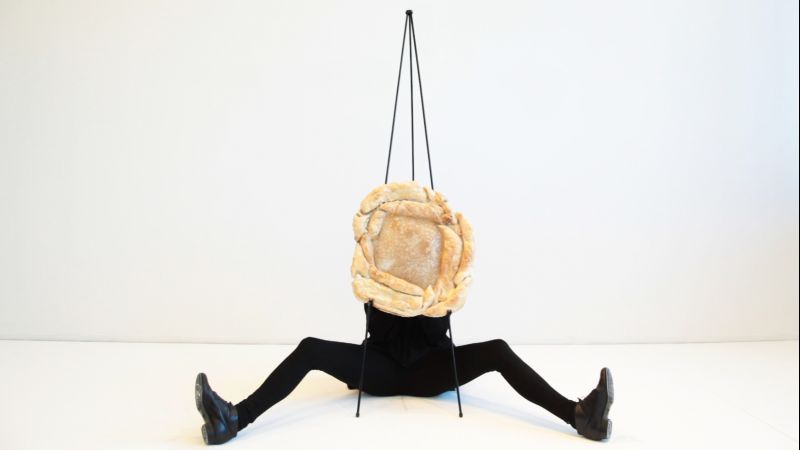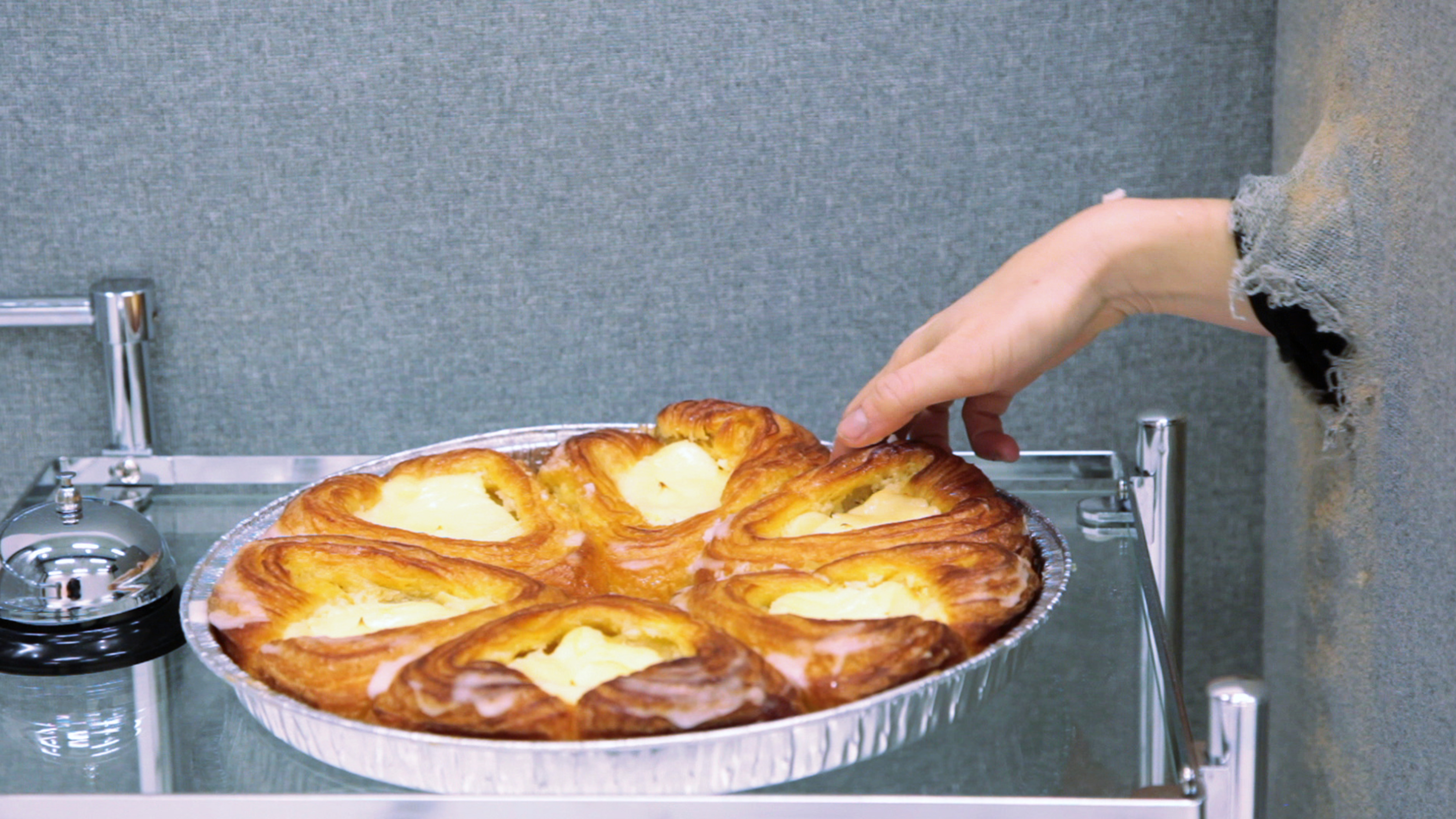It's Okay To Be Many Things at Once: A conversation with Virginia Lee Montgomery
Virginia Lee Montgomery is a mediating American artist employing video, performance and sculpture to enable surreal awakenings within diverse ecosystems of labour. Jacqueline Bell is Curatorial Assistant at Walter Phillips Gallery, The Banff Centre. Montgomery's video work Innovation Porthole (2014) was included in the Walter Phillips Gallery exhibition things you can't unthink.
JACQUELINE BELL (JB): In your video work, Innovation Porthole (2014) you play a character in an office environment. You’ve mentioned that you previously worked in the corporate world as a graphic facilitator, work that you’ve described as “a mediating process-illustrator working at TED-esque conferences.”[1] I’m curious how you relate to this character in the video, or if the character is a performance of a previous self?
VIRGINIA LEE MONTGOMERY (VLM): My experience working in the corporate world was always performative. I was on stages, both metaphorical ones (i.e. enacting social cues) or literal ones (i.e. illustrating live in front of mass audiences at SXSW Interactive, an industry conference on digital technologies). I was always under the gaze, a gaze, and oftentimes the gaze of men since few women populate certain business sectors. I have no idea how I did what I did, but part of it did require inner fragmentation. From psychology of the self, we know the “self” is deeply faceted and always adapting.
In Innovation Porthole, this character is part me and part fiction. I have emphasized various strengths and weaknesses to show both my ability and inability to fit into performance-driven environments. In the videos, I let my agent-self guide the behavior. Thus, I appear more serene on film than in person, where I feel I’m a genuine space alien most the time. But this awkwardness spills through the video, which is why it’s often more comedic than I intend!

Virginia Lee Montgomery, still from “Innovation Porthole”, 2014. HD video, 1:27 seconds on loop. Courtesy the artist
JB: I am hoping we can discuss how you are referencing popular ideas of innovation, both in the title of the video and in your larger body of work. In The New Yorker in 2014, writer Jill Depore argues that popular theories of innovation that came into vogue in the early 2000s require interrogation; “[t]he idea of innovation is the idea of progress stripped of the aspirations of the Enlightenment, scrubbed clean of the horrors of the twentieth century, and relieved of its critics. Disruptive innovation goes further, holding out the hope of salvation against the very damnation it describes: disrupt, and you will be saved.”[2]
Innovation’s buzzword status seems to mask the need for evidence of the validity of the idea. Often uncritically taken as a moral good within both corporate and popular culture, the now-updated buzzword, “disruptive innovation” is used to denote “innovations that create new markets by discovering new categories of customers,” in part, “by harnessing new technologies but also by developing new business models and exploiting old technologies in new ways.”[3] Does Innovation Porthole position itself as a rejoinder to more popular understandings of the term?
VLM: I built Innovation Porthole as a nuanced critique in title and form. At the time, I wasn’t certain who my audience was. Were other people—were other artists—also alarmed by “disruption”? Structurally, the time-space of the video operates as a loop—a perceptual device that repeats an idea over and over. This is a metaphor that asks: how can disruption exist in a circular rhythm in which Financial Quarter 1 will always precede Quarter 4? The “change culture” of innovation is purposely misleading in its ability to confuse pathos with finance, the promise of innovation with mediated loops.
Change requires dismantlement. In thinking about levels of conceptual versus visual construction in my video, I do knowingly employ several marketing tropes—quick jumpcuts, handsy closeups, a well-lit set. I recently came across Brian O'Doherty’s Inside the White Cube: The Ideology of the Gallery Space.[4] Written in the 1970s, I think it is an interesting primer to understand the capitalist-preservationist role of the white cube in relation to the virtual, retail and workplaces of innovation-advocates like Apple or Google. Within their glossy spaces, they too desire to create a timeless space of value suspension.
Metaphorically, these spaces are a psychological update of Neo-Gothic, high-and-bright Enlightenment architecture. But what becomes unnerving in this contemporary workplace manifestation is that the shift of focus is now on emotively engineering employees, as I uncomfortably observed firsthand, and was also recently exposed in The New York Times’ “Inside Amazon: Wrestling Big Ideas in a Bruising Workplace.”[5]
Innovation is indeed a process, but the movement is not always progressive—the market’s insatiable drive necessitates obsolescence. I prefer sustainability and acceptance. In Innovation Porthole, I propose that the protagonist assume the metaphorical mantle of the cheese danish as a way of exiting goal-oriented-idea-culture and instead embrace body, self-acceptance, and mushy selfhood. Oily warmness, yes!
When I make videos, sculptures or live performances, I reassemble fragments of pre-existing ideas, interweave sound samples and congeal ready-made objects into new collaged wholes. This is a very absurdist, Dadaist approach. Most ideas are already out there; the role of the artist is to precipitate them in uncommon ways.

Virginia Lee Montgomery, still from “Innovation Porthole”, 2014. HD video, 1:27 seconds on loop. Courtesy the artist
JB: In the video, the character uses a power drill to bore a hole in a helmet to better fit their ponytail. Tempered with humour, the use of protective gear in this scene recalls the combat of competitive sport. Is the character’s protective gear to guard against the dangers faced by the protagonist in the workplace, such as combative relations between employees? Or is this instead to fend against newer dangers, such as finding that their stable employment has been rendered precarious, a result of the changing political conditions of the last few decades?[6]
VLM: I think new identity-dangers enter the corporate sphere as fast as new technology dislocates our subjectivity. These dangers are subcutaneous. It’s hard enough to distinguish between a public, interpersonal self and a self which is private. On the surface, the identity of the pony-tailed woman appears benign, well-groomed and patriarchy-approved. But, just as Patti Smith said, “gender is a drag.” The portrayal of individuality and the presentation of self within a corporate environment can also be a construction.
In the corporate workplace, we build up exterior identities to protect our inner selves. This is the slow-burn horror that I encountered. By neoliberal standards, my external blonde-ponytail femininity (“good”) combined with my inner struggle to adapt to performance assessments (“bad”) made me innately subversive. This is why I am still returning again and again to this metaphor of activating my body and forcing myself into ambiguous, non-linear, perceptual flux as a “solve” for a solid-state-identity. It’s okay to be many things at once.
For me, I didn’t get this until I saw my 10,000th half-melted cheese danish at a corporate buffet. It was there that I realized how dislocated I was from my own physicality, my own identity. I wanted to melt. I needed to manifest a space on my own terms.
JB: We follow the character as she engages in activities that I read as forms of absurdist self-improvement, like tightrope walking while being seated in an office chair. The scene makes me think of the drive for constant self-improvement that has taken on new permutations in the neoliberal era. In a recent article, philosopher Pierre Dardot and sociologist Christian Laval argue that the neoliberal enterprise is “ideally depicted as the site of all innovation, constant change, continual adaptation to variations in market demand, the search for excellence, and ‘zero defects.’”[7] This impacts the working subject’s sense of self, as they “conform internally to this image by constant self-work or self-improvement. His or her own expert, own employer, own inventor, and own entrepreneur [...].”[8]
Are ideas of self-improvement of interest to you in your work?
VLM: In my experience, it is not so much about self-improvement as it is about self-preservation in such neoliberal environments. The “self” would be the operable word here and deserves definition or portrayal as both a term for a group but also the individual that has been programmed to work and improve continually. It’s the idea of planned psychological obsolescence, as though the self is not good enough as it is. So the activities you see in the video are not so much about improvement as they are portrayals of ridiculous hoops that I must jump through, reach through, squeeze through in order to be acceptable...until I become a giant, yonic pastry.
To stay still, observe the present tense, dream without definable goals and see paradox in everything is culturally not conducive to capitalists looking for new variations for selling the same product.

Virginia Lee Montgomery, still from “Innovation Porthole”, 2014. HD video, 1:27 seconds on loop. Courtesy the artist
JB: Objects that feature heavily in the video include power drills, blonde ponytails and cheese danishes. These objects seem to function like comedic props; can you speak to how you are thinking about their use in the work?
VLM: Blonde hair is so strange to me! It’s difficult to separate out its signifier and signified. That sandy colour, keratin materiality and fetishized charge are tightly braided together. As a hairy blonde woman myself, it also grows out of my skin whether I want it to or not. Hair is uncanny in its ability to index time while also being fundamentally dead, like a zombie.
Cheese danishes similarly operate as complex metaphors. They represent a comically banal omnipresence. Body as bread is ancient, but the tragicomedy of the cheese danish lies in its gooey, fatty cream cheese interior. It melts with an unrelenting degree of pathos when left sitting out all day under corporate fluorescents. They’re temporal in that way, cheese danishes—little cathartic oases of oil.
JB: In one scene the character sits behind a flip chart easel, and on the easel is a giant cheese danish. Her head is obscured and replaced by the pastry. I think about associations between the female body and food as twinned subjects of desire, and ideas of cannibalism that come up in classic works on the subject, like Margaret Atwood’s 1969 novel, The Edible Woman. How are you thinking about these ideas in a corporate context, as well as in relation to current feminist discourses?
VLM: Atwood’s The Edible Woman is a really great reference point for discussing the evolution of body politics, desire and control. Cheese danishes are extremely yonic and I love that about them. My Dewalt drill when fitted with my four inch bi-metal hole-saw is my yonic-maker. My objects can talk for me when language feels too absolute. Because these objects have slippage as signs, I can use them as decoys for myself while I’m grappling through a world that still grapples with misogynist traditions.
What I love about current feminist discourse is it acknowledges that gender is a lot more nuanced than we could ever possibly imagine. Science fiction, as Atwood has shown us, is brilliant in modeling alternative futures (whether horrific or utopian) for us to analyze via a looking-glass self.

Virginia Lee Montgomery, still from “Innovation Porthole”, 2014. HD video, 1:27 seconds on loop. Courtesy the artist
JB: Given the analysis of corporate culture present in your work I’m curious about your thoughts on the debates around Facebook COO Sheryl Sandberg’s much discussed 2013 book, Lean In: Women, Work and the Will to Lead, self-described as “sort of a feminist manifesto” for women in the corporate world.[9]
Sandberg’s book, which The New York Times sums up as imploring women “to assertively pursue career ambitions, ‘combine niceness with insistence’ and demand that their partners share equally in child care,”[10] has come under fire from feminist thinkers such as bell hooks, who argues that Sandberg “makes it seem that privileged white men will eagerly choose to extend the benefits of corporate capitalism to white women who have the courage to ‘lean in,’” and refuses to acknowledge the need for an intersectional and class-based analysis of structural inequality, instead offering “a narrow definition of feminism that obscures and undermines visionary feminist concerns.”[11] Is this a cultural debate that you find relevant to your work?
VLM: Supposedly the expression to “lean in” came from a sports idiom about shifting one's body weight toward someone or something. Because feminism is about equality, the Sandberg version of feminism fails to be inclusive. Sandberg’s deployment of this metaphor implies that women need to physically shift their bodies, and continue to adapt themselves, rather than the existent imperialist white supremacist capitalist patriarchy adapt itself. When one thinks about this in regards to physical choreography it’s insane—Sandberg is asking women to physically lean in to a force which is not interested or presently equipped to support them, but rather is built to let them self-fracture and be erased.
In my mind, much of the historical force behind male privilege continues to be perpetuated by histories that erased women. For example, one of the first narrative, fiction films was created by French director, Alice Guy Blaché. It was entitled La Fée aux Choux and was made in 1896! Within her own lifetime she was acutely aware that film historians were erasing her work despite Blaché’s significant contributions in syncing sound, employing interracial casting and inventing several special effects.
So how do we prevent this? Create revised narratives of radical inclusion, whether about women or the diverse contribution of creative labour. Change the dialogue to represent something other than privilege and programming. Presently, I’m interested in seeing what is hard to see, what has not been shown to me, what has been kept from me, and understanding that we do not simply “lean in” to action but actions also lean in to us.
This interview was previously published in the catalogue for the Walter Phillips Gallery exhibition, "things you can’t unthink", and was titled "It's Okay to be Many Things at Once, Jacqueline Bell in conversation with Virginia Lee Montgomery".
[1] Conversation with the artist, January 4, 2016.
[2] Depore, Jill. “The Disruption Machine,” The New Yorker. June 23, 2014. http://www.newyorker.com/magazine/2014/06/23/the-disruption-machine. Accessed December 30, 2015.
[3] “What disruptive innovation means,” The Economist. January 25, 2015. http://www.economist.com/blogs/economist-explains/2015/01/economist-explains-15. Accessed December 30, 2015.
[4] O'Doherty, Brian. 1999. Inside the White Cube: The Ideology of the Gallery Space. Berkeley: University of California Press.
[5] Kantor, Jodi and Streitfeld, David.”Inside Amazon: Wrestling Ideas in a Bruising Workplace,” The New York Times. August 15, 2015. http://www.nytimes.com/2015/08/16/technology/inside-amazon-wrestling-big-ideas-in-a-bruising-workplace.html. Accessed January 11, 2016.
[6] Kalleberg, Arne L. “Precarious Work, Insecure Workers: Employment Relations in Transition,” American Sociological Review, 2009: 74. http://xn--djrptq8e1xcz4du81e.tw/social/upload/P_320110326164208.pdf. Accessed January 3, 2016.
[7] Dardot, Pierre and Laval, Christian. “The New Way of the World, Part 1: Manufacturing the Neoliberal Subject,” e-flux, 2014. http://www.e-flux.com/journal/the-new-way-of-the-world-part-i-manufacturing-the-neoliberal-subject/. Accessed December 30, 2015.
[8] Dardot, Pierre and Laval, Christian.“The New Way of the World, Part 1: Manufacturing the Neoliberal Subject.”
[9] Sandberg, Sheryl. 2013. Lean In: Women, Work, and the Will to Lead. New York: Knopf. 9.
[10] Rich, Motoko. “Making a Word Meme,” The New York Times. May 17, 2013. Accessed January 6, 2016.
[11] hooks, bell. “Dig Deep: Beyond Lean In,” Feminist Wire, October 28, 2013. http://www.thefeministwire.com/2013/10/17973/. Accessed December 30, 2015.